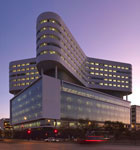It’s no wonder that some of the hallmark American television dramas are centered on hospitals. These are the places where life begins, ends, and joyfully extends, a tangle of rooms and hallways and high-tech equipment employed by a true cross-section of humanity who make up patients and caregivers.

Essential to all of this are the people who design and build what are in many cases magnificent structures (Rush University Medical Center being one shining example). And those people—architects, engineers, contractors, interior designers, and owners—converge every October to share ideas and push the industry farther into an environmentally and physically sustainable future.
Their ability to gather is in large part thanks to the work of Jenabeth Ferguson, event director and program manager of the Healthcare Facilities Symposium & Expo, a gathering of 3,000 professionals and 200 exhibitors in Chicago. Ferguson shares what she’s learned about hospitals—going green for a while, it turns out—since she began working on the show in 1998.
How big is this industry?
In the US alone, healthcare construction spending for 2012 is expected to total $43 billion, according to Associated Builders and Contractors. We have some international Symposium attendees as well.
Who goes to this show and why?
This is the event for everyone involved in the construction and renovation of healthcare facilities. It’s the first place for people who oversee how the physical environment affects healthcare delivery. Importantly, it’s cross-functional. Architects really learn from those who manage or work in a facility and vice versa.
How would you describe the speakers at this conference?
It’s a broad range of people who can educate each other. We had to select between 250 speaker and panel submissions for 70 session slots. The best sessions are those that have multiple disciplines present.
Are there defining characteristics with healthcare designers and builders?
Without a doubt these are the most passionate and dedicated professionals in their field. They are truly impacting peoples’ lives. It’s much more than just bricks and mortar.
The 2011 show had a healing garden exhibit. How much do biophilic elements play a role in healing?
We’ve had special green exhibits since 2007, where 12 to 15 vendors provide components of something that illustrates a green patient experience. A healing garden is for patients, family, and staff to experience a tranquil space.
How much does sustainability play into design in hospitals and other types of healthcare facilities?
These are big buildings that are open and working 24/7, with equipment that requires a lot of power. Because they are big consumers of energy, healthcare has been working on green and sustainable practices for a long time. Conferences annually have between eight and twelve proposals on energy. In existing structures, renovations and retrofitting of lighting are the low-hanging fruit. Waste disposal has and remains a big topic in Symposium sessions and with exhibitors.

